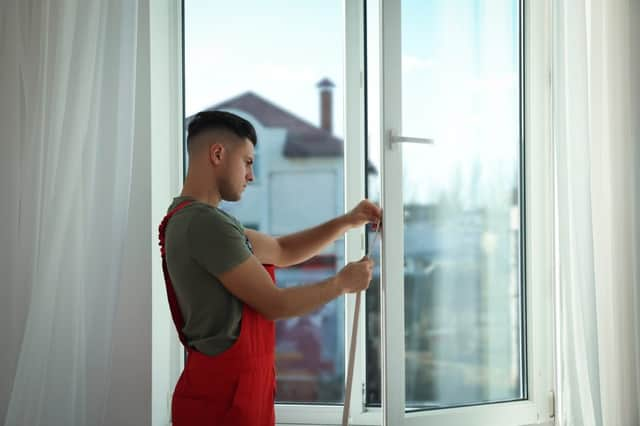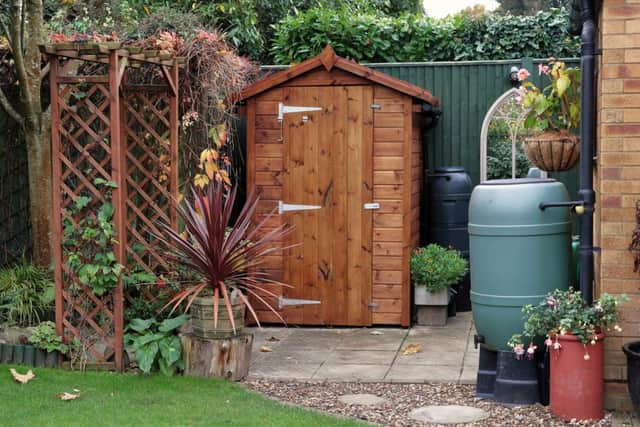Going Green - Take steps to ensure your entire home is always draught-free


Latest article from Angela Terry
Green Green campaigner and consumer expert, Angela Terry, separates climate change facts from fiction and here she explains how you can take simple, practical steps to help save the planet. Follow @ouronehome & visit https://onehome.org.uk/ for more advice.
Q: I’m so worried about my gas bill.Are there any green tips that can help cut it?
A: Yes, you can make your home more energy efficient, save money and cut your carbon footprint with some easy DIY hacks.
Turn it down
Start with your thermostat.
A comfortable indoors temperature for most people is 19 degrees Celsius.
Advertisement
Hide AdAdvertisement
Hide AdIf you turn it up any higher, you’ll pay too much for your bills.
Obviously, if you have any vulnerable people at home, you may need to keep their room a little hotter.Please check with their doctor.
Dress those windows
As soon as it gets dark, the temperature drops, so make sure all your windows have blinds, curtains or shutters over them.
Blackout blinds and thermally-lined curtains are the best options.
Advertisement
Hide AdAdvertisement
Hide AdIf your curtains aren’t lined, use curtain hooks to add an extra layer of fabric.
Block those draughts
In the UK, we have the leakiest homes in Western Europe.
Many of us are paying for precious heat to escape into the atmosphere around our homes.
That’s why it’s a good idea to find where all your draughts are and block them.
The best time to do this is on a windy day, with some water on the back of your hand.
Advertisement
Hide AdAdvertisement
Hide AdYou can buy inexpensive foam strips from any high street DIY shop.
They’ve sticky tape on the back so you can easily use them to plug gaps around your windows.
When it comes to gaps under front and back doors, you can block them with a brush draught excluder that you fit to the bottom of them.
Or, if you prefer, you can use an old fashioned draught excluder made from remnants of old fabric.
Advertisement
Hide AdAdvertisement
Hide AdLittle-used rooms
If you have rooms you don’t often use – like a spare room or dining room – then make sure their radiators are turned down low.
Loft insultation
Heat rises, meaning that 25 per cent of the heat in your home escapes through the roof – unless you properly insulate it.
Mineral wool is the recommended insulation.
Ensure it is 30cm deep.
If you have existing insulation and it’s not thick enough, top it up.
This is a relatively easy DIY task that many people can do themselves.
Advertisement
Hide AdAdvertisement
Hide AdAlternatively, you can pay for a tradesperson to do it for you.
They can also fit boards over the insulation, so you can still use your attic for storage.
Meter readings
Keep an eye on how much energy you’re using by taking regular meter readings.This way you can check you’re on the best tariff you can find.
Celebrity spot
As the energy crisis continues, even celebrities are getting off gas. Loose Women star Stacey Solomon has swapped her beloved old gas AGA for a modern electric one to save energy and the environment.
Advertisement
Hide AdAdvertisement
Hide Ad

As she does up the £1.2 million Essex home she shares with actor Joe Swash and their kids, she’s sharing social media updates.
In one, she says she loved Audrey, the black AGA that came with the house, but still sent it back to the manufacturer for repurposing and switched to an electric model.
Green swap
Buy a water butt and try to avoid using your garden hose.


As global temperatures rise, heatwaves are becoming more common, resulting in more hosepipe bans.
Plan ahead and invest in a water butt and store rainwater. It’ll reduce bills if you have a water meter.
All about Earth Day and how best to celebrate it


Friday April 22 is Earth Day.
Advertisement
Hide AdAdvertisement
Hide AdStarted in the US way back in 1970, it’s a global day of education about environmental issues.
It was the brainchild of Gaylord Nelson, a senator from Wisconsin, who’d long been worried about America’s polluted air and water.
History
The first Earth Day was a landmark event.
On April 22, 1970, 20 million Americans – ten per cent of the US population at the time – took to the streets to demand a new way forward for the environment.
It gave birth to the modern environmental movement and also led to the passing of landmark US environmental laws.
Many other countries soon adopted similar laws.
Advertisement
Hide AdAdvertisement
Hide AdIn 2016 the United Nations chose Earth Day as the day to sign the Paris Climate Agreement.
Theme
Each year, Earth Day has a different theme.
This year it’s Invest in our Planet, underlining that a green future is a prosperous future – and that we all have a role to play in it.
Events
On the day itself you can tune into Earth Day Live on the earthday.org website.
During this online event, experts will examine ways to protect our shared home.
Advertisement
Hide AdAdvertisement
Hide AdTopics include climate restoration, regenerative agriculture, plastic pollution, food security, the green economy and universal climate literacy.
In-person events are also taking place all over the world, including throughout the UK.
There’s a map on the Earth Day website.
You can even host your own event and submit its details to the official site in advance.
Suggestions include a community environment discussion group or a lecture from a local climate expert.
Advertisement
Hide AdAdvertisement
Hide AdClean-up
You could also take part in the linked Great Global Clean-up.
A worldwide campaign to remove billions of pieces of rubbish from neighbourhoods, beaches, rivers, lakes and parks, it’s all about reducing waste and plastic pollution as well as improving habitats and preventing harm to wildlife and humans.
You can download a toolkit to set up your own event or join an existing clean-up.
Take action
The Earth Day website is packed full of ideas for how you can take climate action at different levels.
Advertisement
Hide AdAdvertisement
Hide AdWhether you’re new to the whole going green thing or a seasoned eco-warrior, there are ideas for everyone.
Of course, if you’d like some more UK-specific ideas, you can always visit the One Home website too!
Fact or fiction
Washing at cold temperatures doesn’t get clothes clean. False! Washing at 30C is fine unless clothes are stained. Then try a higher temperature. Washing at 30C degrees uses 38 per cent less energy than washing at 40 degrees.
For previous articles visit:
Advertisement
Hide AdAdvertisement
Hide Ad